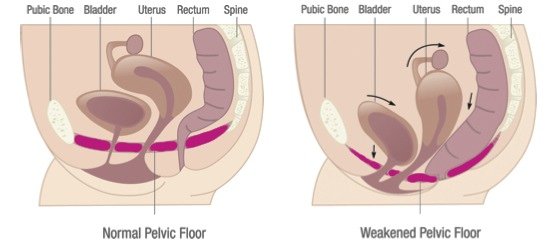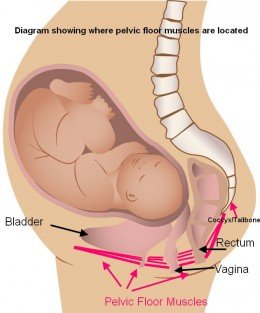Here are some common questions that women have about their pelvic health.
1. Is Pelvic Floor Exercises before Pregnancy is Beneficial?
Yes, pelvic floor exercises before pregnancy can be highly beneficial for your pelvic floor muscle to prepare for the growing baby and prevent it from being strained too much during pregnancy.
It is advisable to start pelvic training before pregnancy to strengthen and prepare the pelvic floor muscle for the growing baby. The pelvic floor muscle can weaken drastically after one or multiple pregnancies with the lack of proper pelvic training, leading to problems like decreased quality of sexual experience, urinary incontinence, and chronic backache.

2. How Does Pregnancy Affect The Pelvic Floor?
During pregnancy, the weight of the baby is fully deposited on the pelvic floor. For 9 consecutive months, the pelvic floor muscle is continuously absorbing and supporting the increasing weight of the growing baby.
Pregnancy is extremely strenuous on the pelvic floor, and it is also the main reason behind the start of many women experiencing mild incontinence as well as decreased quality of their sexual experience, from as early as during pregnancy to later in life.
Without deliberate pelvic training, the pelvic floor muscle is unable to return to be the same as it was before pregnancy. You may imagine an overstretched rubber band for perspective. Unlike an overstretched rubber band, our pelvic floor muscle is capable of being toned and strengthened again via pelvic floor exercise.

3. Does C-Section delivery maintain vagina tightness?
Some women opt for c-section delivery to protect their vagina from the trauma of natural delivery.
After childbirth, many of us feel a change in their sexual experience- a feeling of looseness and a lack of sensation during intercourse. The sensation you feel during sexual activities is largely affected by the health of our pelvic floor muscle. The healthier our pelvic floor muscle is, the more sensation we feel during sex. During pregnancy, our pelvic floor muscle is very strained from supporting the weight of the growing baby.
After c-section delivery, the vagina will look the same as before, but only on the outside. On the inside, your pelvic floor muscle has already been stretched like a rubber band that has been stretched for 9 months. That is why, even though the vagina may look the same as before from the outside, it does not feel the same anymore. The over-stretched pelvic floor muscle cannot go back to its orignal state by itself-only with deliberate exercise and pelvic training can it heal and strengthen.
The physical and visible state of the vagina (stretched or not) does not determine the tightness of the vagina.
The tightness of the vagina comes from the strength of the pelvic floor muscle that wraps around the vaginal canal, giving the vagina its structure and grip.

Regardless of the method of delivery, the strain on the pelvic floor muscle comes from pregnancy itself and not the delivery. Like every other muscle in the body, the pelvic floor muscle can only be strengthened with exercise. Doing pelvic exercises correctly can effectively help us improve bladder control, regain her sexual sensations and prevent backache.
4. Does natural delivery increase the risk of incontinence?
Many studies have shown the risk of developing urinary incontinence from natural delivery and cesarean section delivery to be the same. High risks of female incontinence exists due to the strain on the pelvic floor muscle during pregnancy, irrespective of the method of delivery.
This is because the strain on the pelvic floor muscle comes mainly from the pregnancy itself, during which the weight of the growing baby is fully absorbed by the pelvic floor. In terms of bladder control, the pelvic floor muscle wraps tightly around the opening of the bladder like a rubber band and only relaxes when the bladder is full and a signal is sent to the brain to release the urine. Incontinence is caused by the inability to hold in urine due to the weakening of the pelvic floor muscles.
Deliberate pelvic exercise can help to strengthen the pelvic floor muscles. When done correctly, pelvic exercise can help you improve bladder control, regain sexual sensations and relieve backache.
5. How Can I Prevent Incontinence?
Most women experience incontinence due to the weakness of the pelvic floor muscle, that could be due to many reasons, from pregnancy to frequent heavy lifting. Urinary incontinence can be prevented by keeping the pelvic floor muscle strong and healthy through deliberate and accurate pelvic training. Ensuring you are doing your pelvic floor exercises correctly is the first step to preventing incontinence. When done correctly, regular pelvic training can be extremely effective in strengthening the pelvic floor muscle thus improving bladder control.
6. Does C-section Delivery Reduce the Risk of Incontinence?
Many women may think that choosing C-section as a method of delivery can prevent many undesirable effects of natural childbirth. Is it true?
Pregnancy, regardless of the method of delivery, can cause a huge strain on the pelvic floor muscles that can lead to incontinence later in life. Many studies have shown that the risks of developing urinary incontinence (leak) from natural delivery and C-section delivery to be the same. C-section delivery is said to offer no more protection against incontinence than normal childbirth.
It is important to understand that the stress on the pelvic floor comes from the 9-month pregnancy period itself. During pregnancy, on top of supporting the pelvic organs and back, the pelvic floor absorbs and supports the weight of the growing baby. By the end of the 9 months, the pelvic floor is strained like a rubber band that has been stretched for 9 consecutive months. This prolonged stress on the pelvic floor is the reason women experience a loss of bladder control and a drop in the quality of their sexual experience, among other pelvic functions.
Vibrance specializes in providing treatment options for treating women’s pelvic floor dysfunction. Feel free to contact us for more inquiries about pelvic health.
